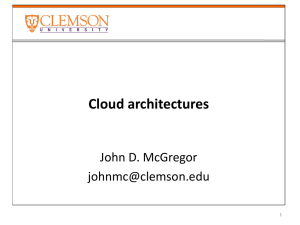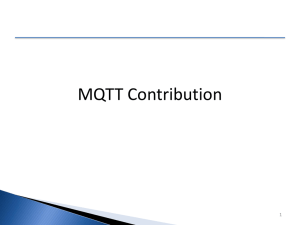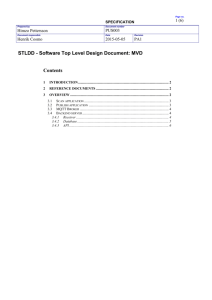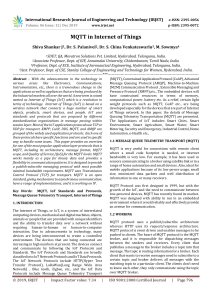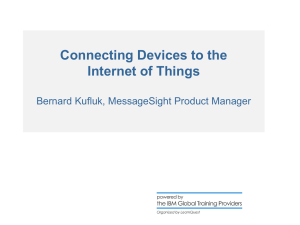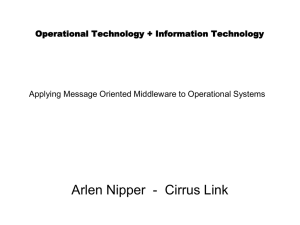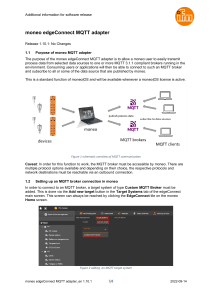Mobile Location Sharing: An Energy Consumption Study
advertisement
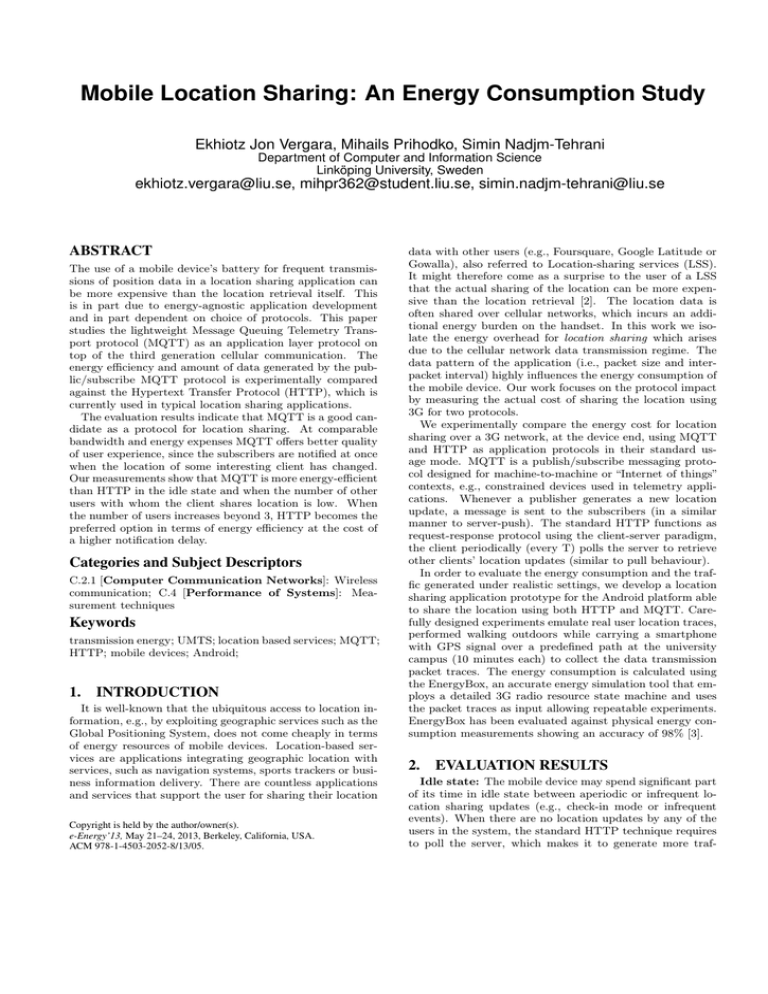
Mobile Location Sharing: An Energy Consumption Study Ekhiotz Jon Vergara, Mihails Prihodko, Simin Nadjm-Tehrani Department of Computer and Information Science Linköping University, Sweden ekhiotz.vergara@liu.se, mihpr362@student.liu.se, simin.nadjm-tehrani@liu.se ABSTRACT The use of a mobile device’s battery for frequent transmissions of position data in a location sharing application can be more expensive than the location retrieval itself. This is in part due to energy-agnostic application development and in part dependent on choice of protocols. This paper studies the lightweight Message Queuing Telemetry Transport protocol (MQTT) as an application layer protocol on top of the third generation cellular communication. The energy efficiency and amount of data generated by the public/subscribe MQTT protocol is experimentally compared against the Hypertext Transfer Protocol (HTTP), which is currently used in typical location sharing applications. The evaluation results indicate that MQTT is a good candidate as a protocol for location sharing. At comparable bandwidth and energy expenses MQTT offers better quality of user experience, since the subscribers are notified at once when the location of some interesting client has changed. Our measurements show that MQTT is more energy-efficient than HTTP in the idle state and when the number of other users with whom the client shares location is low. When the number of users increases beyond 3, HTTP becomes the preferred option in terms of energy efficiency at the cost of a higher notification delay. Categories and Subject Descriptors C.2.1 [Computer Communication Networks]: Wireless communication; C.4 [Performance of Systems]: Measurement techniques Keywords transmission energy; UMTS; location based services; MQTT; HTTP; mobile devices; Android; 1. INTRODUCTION It is well-known that the ubiquitous access to location information, e.g., by exploiting geographic services such as the Global Positioning System, does not come cheaply in terms of energy resources of mobile devices. Location-based services are applications integrating geographic location with services, such as navigation systems, sports trackers or business information delivery. There are countless applications and services that support the user for sharing their location Copyright is held by the author/owner(s). e-Energy’13, May 21–24, 2013, Berkeley, California, USA. ACM 978-1-4503-2052-8/13/05. data with other users (e.g., Foursquare, Google Latitude or Gowalla), also referred to Location-sharing services (LSS). It might therefore come as a surprise to the user of a LSS that the actual sharing of the location can be more expensive than the location retrieval [2]. The location data is often shared over cellular networks, which incurs an additional energy burden on the handset. In this work we isolate the energy overhead for location sharing which arises due to the cellular network data transmission regime. The data pattern of the application (i.e., packet size and interpacket interval) highly influences the energy consumption of the mobile device. Our work focuses on the protocol impact by measuring the actual cost of sharing the location using 3G for two protocols. We experimentally compare the energy cost for location sharing over a 3G network, at the device end, using MQTT and HTTP as application protocols in their standard usage mode. MQTT is a publish/subscribe messaging protocol designed for machine-to-machine or “Internet of things” contexts, e.g., constrained devices used in telemetry applications. Whenever a publisher generates a new location update, a message is sent to the subscribers (in a similar manner to server-push). The standard HTTP functions as request-response protocol using the client-server paradigm, the client periodically (every T) polls the server to retrieve other clients’ location updates (similar to pull behaviour). In order to evaluate the energy consumption and the traffic generated under realistic settings, we develop a location sharing application prototype for the Android platform able to share the location using both HTTP and MQTT. Carefully designed experiments emulate real user location traces, performed walking outdoors while carrying a smartphone with GPS signal over a predefined path at the university campus (10 minutes each) to collect the data transmission packet traces. The energy consumption is calculated using the EnergyBox, an accurate energy simulation tool that employs a detailed 3G radio resource state machine and uses the packet traces as input allowing repeatable experiments. EnergyBox has been evaluated against physical energy consumption measurements showing an accuracy of 98% [3]. 2. EVALUATION RESULTS Idle state: The mobile device may spend significant part of its time in idle state between aperiodic or infrequent location sharing updates (e.g., check-in mode or infrequent events). When there are no location updates by any of the users in the system, the standard HTTP technique requires to poll the server, which makes it to generate more traf- Normalised energy consumption 1 HTTP ï ave. > 0 users HTTP ï 0 users MQTT ï 9 users MQTT ï 6 users MQTT ï 3 users MQTT ï 0 users 0.9 0.8 0.7 0.6 0.5 0.4 0.3 0.2 0.1 15 30 45 0.15 0.1 0.05 0 0 1 2 3 4 5 Location update interval (minutes) Normalised energy consumption 0.2 Empirical CDF of checkïins fic and consume more energy than the MQTT technique. The longer the update period T, the smaller the energy consumption becomes. However, the delay between the users’ location update and the reception of it becomes greater. Active state: When actual location data is transmitted, the low protocol overhead and the publish subscribe nature of MQTT creates lower amount of data traffic and makes MQTT more energy-efficient when the number of users in the system is low. When the load is increased, the HTTP technique takes advantage of aggregating all the location updates in a single burst being more energy-efficient when there are many updates. However, this comes at the cost of delaying the reception of the updates at the client side. This is shown in Fig. 1, where the energy consumption of HTTP and MQTT is shown normalised to the greatest value of MQTT with 9 users (285 Joules). We vary the update period T and the number of simulated users that the client shares location data with, i.e., the load in the system. The case of 0 simulated users represents when only the client updates its own location. The energy consumption of HTTP is approximately the same for 3, 6 and 9 users, and therefore we only show the average value to compare with MQTT (shown as HTTP with users in Fig. 1). 1 JSON base64 0.8 0.6 0.4 0.2 0 15 30 45 60 Update period (seconds) Figure 2: Empirical CDF of inter-update interval in minutes of the 22,387,930 check-ins from 224,804 users (left) and normalised energy consumption for the HTTP data encoding (right). ins, and a single user rarely has more than 1 short consecutive updates per 1 minute (93% of the users do not have any updates in intervals shorter than 60 seconds). Therefore, MQTT appears to be the protocol of choice due to its instant location update delivery and lower energy consumption. Data format: We next studied the contribution of data format to transmission energy footprint. Data format impacts the size of the payload and therefore the data pattern in terms of packet size. We show that applications using HTTP would benefit from using a compact data encoding format (Base64 Content-Transfer-Encoding format) over the standard verbose format (JavaScript Object Notation). Fig. 2 (right) shows the normalised energy compared to the update interval. It shows that the energy consumption can be reduced by 16 to 50% at the cost of losing human readability. 60 Update period (seconds) Figure 1: Normalised energy consumption for HTTP and MQTT in active state. For 0 users, the energy consumption of HTTP and MQTT is similar. Fig. 1 shows that MQTT is more energy-efficient for shorter update periods when the number of users is 3. When the update period is increased, HTTP consumes less than MQTT since it updates the location of the users once every T. The HTTP protocol becomes more efficient when the number of users increases (6 and 9). The reason is that HTTP transmits all the data in a single burst (polling nature), at the cost of location sharing delay. Protocol for check-in: Next we studied the energy footprint of the protocols when performing check-ins using data collected earlier [1]. Our study shows that MQTT is a more appropriate protocol for check-ins. We are interested in studying the time between updates (inter-update interval) for each user as an input to guide choosing between the two protocols. We calculate the inter-update interval for each user using the above dataset. Fig. 2 (left) shows the empirical CDF of the inter-update interval of all the users in the dataset for short location update intervals in minutes. It shows that 15% of the general inter-update interval is longer, which causes the idle time to dominate the active time. The inter-update intervals shorter than 1 minute represent 5.6% of the total number of check- 3. CONCLUSION MQTT instantly delivers location data, creates less traffic and is more energy-efficient in the idle state or where number of sharing nodes is low. MQTT also appears as a suitable protocol option for check-in mode. When the load increases, aggregating location updates as the HTTP technique does become more competitive at the cost of delay. This suggests that an adaptive protocol that can switch the operation mode based on the number of users in the system to reduce the energy consumption might be viable. 4. REFERENCES [1] Z. Cheng, J. Caverlee, K. Lee, and D. Z. Sui. Exploring Millions of Footprints in Location Sharing Services. In Proceedings of the Fifth International Conference on Weblogs and Social Media. AAAI, July 2011. [2] M. Kjærgaard. Location-based services on mobile phones: minimizing power consumption. IEEE Pervasive Computing, 11(1):67 –73, 2012. [3] E. J. Vergara and S. Nadjm-Tehrani. Energybox: A trace-driven tool for data transmission energy consumption studies. In Proceedings of the International Conference on Energy Efficiency in Large Scale Distributed Systems (EE-LSDS 2013), Lecture Notes in Computer Science. Springer, April 2013.
